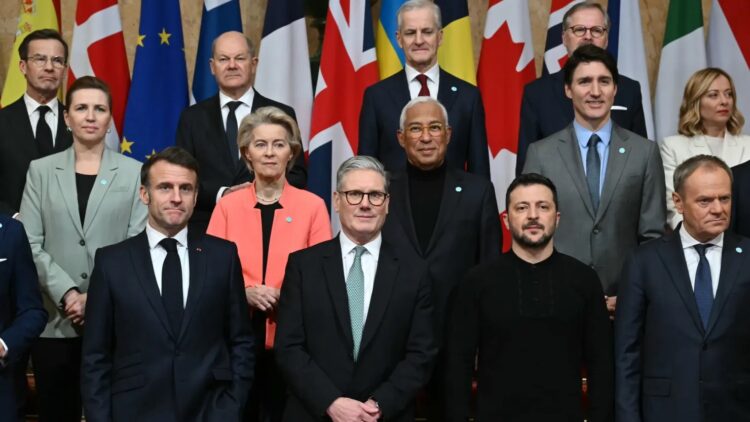European leaders ratcheted up their attempts at brokering a peace deal in Ukraine as they worked to mend the tense relationship between Washington and Kyiv following last week’s heated Oval Office meeting between U.S. President Donald Trump and Ukrainian President Volodymyr Zelenskyy.
At an emergency London summit on Sunday, European leaders convened to advance their own peacekeeping proposals for Ukraine. The summit was held with the intent of reaffirming Europe as the key negotiator in upcoming negotiations and alleviating fears about the growing direct bilateral negotiations between the U.S. and Russia that have displaced European players.
Europe Pushes Peacekeeping Proposal
British Prime Minister Keir Starmer explained that several European nations had formed a “coalition of the willing” that would be prepared to deploy peacekeeping troops to Ukraine if there was a signed ceasefire agreement.
“Through my discussions over recent days, we’ve agreed that the U.K., France, and others will work with Ukraine on a plan to stop the fighting. Then we’ll discuss that plan with the United States and take it forward together,” Starmer told the BBC.
According to reports, both French President Emmanuel Macron and Starmer are advocating for a one-month truce between Russia and Ukraine as a test of Moscow’s commitment to peace at first. However, Russia has firmly rejected the deployment of European troops in Ukraine, and the U.S. has openly said that it will not deploy American troops as peacekeepers.
A Broken U.S.-Ukraine Relationship
The European diplomatic pressure follows a dramatic White House confrontation last Friday, in which Trump and Vice President JD Vance publicly rebuked Zelenskyy for ingratitude towards U.S. military aid and for fueling global tensions. The exchange has further strained Kyiv’s relations with Washington, leaving Europe to now play the role of a possible intermediary.
Uncertainty Over Europe’s Role
While European leaders are eager to take on a more substantial role in Ukraine’s destiny, analysts caution that the details of their peace plan remain opaque. The summit helped to highlight Europe’s desire to take leadership, as Gesine Weber, a fellow at the German Marshall Fund, noted, “especially as tensions between the U.S. and Ukraine could not be higher.”.
“We are wait-and-see to see how much Washington is going to invest in this plan,” Weber told CNBC’s “Squawk Box Europe.”
European nations have also struggled with a unified stance on long-term military aid to Ukraine, as well as the continent’s overall security. Ukraine is not a member of either NATO or the European Union, so it is more difficult for European governments to make firm guarantees.
U.S. and Russian Reactions
The U.S. and Russia have not yet made an official response to Europe’s latest peacekeeping efforts. But Trump shared on Sunday on Truth Social, “We should be less concerned with Putin and more concerned with crime, so we do not end up like Europe.”.
Experts warn that without Washington’s backing or ooperation with Moscow, European peacekeeping aspirations might fail. Teneo deputy research director Carsten Nickel said that while the London summit had high-flying rhetoric, concrete accomplishments were few beyond new air defense commitments and funds for Ukraine.
“The next move will be to extend the ‘coalition of the willing’ from Britain and France to other willing European states,” Nickel said. Nevertheless, he cautioned that Europe’s proposal may complicate further U.S.-Russia relations. “Trump’s urge for a prompt ceasefire—perhaps tied to a minerals mining deal—could be at odds with Europe’s more sophisticated plan for the security of Ukraine.”
As Europe is positioning itself as a key mediator, the question is: Can it successfully bridge the growing gap between Washington and Kyiv and lead Ukraine to an enduring peace?
Can Europe Broker Peace in Ukraine? Leaders Push for New Ceasefire Proposal After Zelenskyy’s Clash With Trump
ADVERTISEMENT
ADVERTISEMENT









